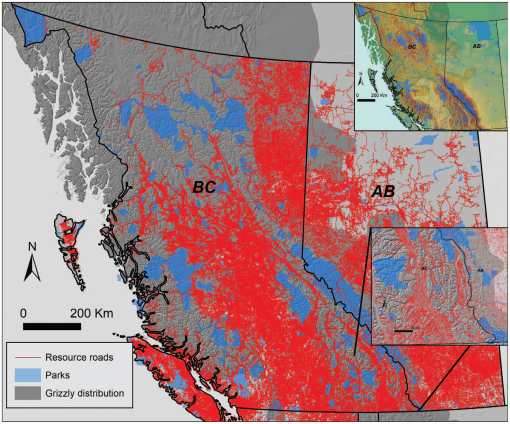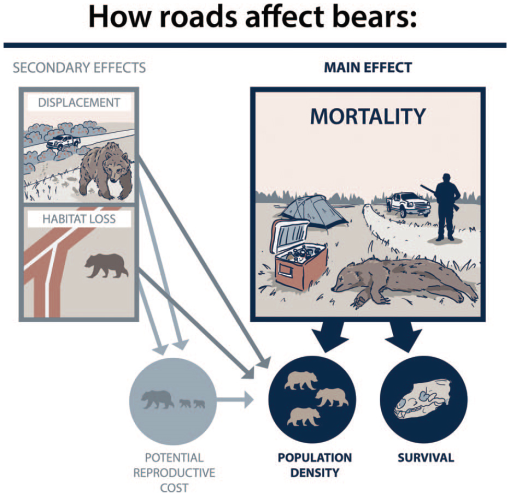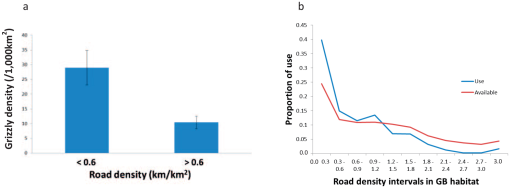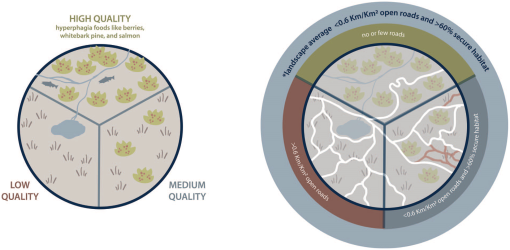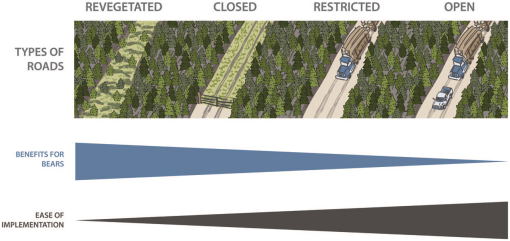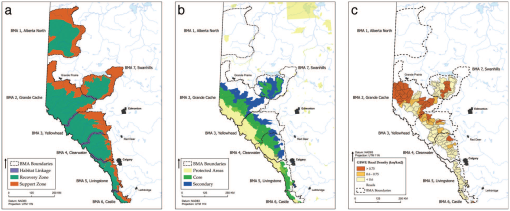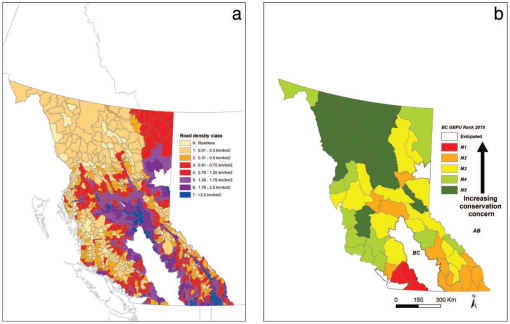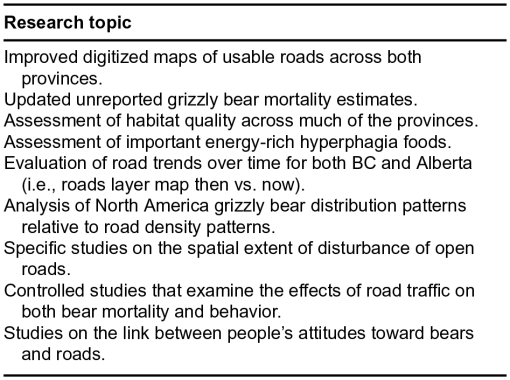Table 1.
A glossary of terms applicable to our review of the scientific literature on the relationship between grizzly bears (Ursus arctos), human motorized access, and the efficacy of motorized access control as a tool to benefit grizzly bear conservation in western Canada.
Fig. 1.
Grizzly bear (Ursus arctos) distribution and resource roads across Alberta and British Columbia, Canada. Resource roads are non-highway, dirt or gravel roads used to access timber and mining resources. This map does not reflect all Off Highway Vehicle tracks. The upper right inset displays topographic relief and the lower left inset provides a close up to show variation in road densities within southeast British Columbia.
Fig. 2.
Schematic of mechanisms of grizzly bear (Ursus arctos) response to roads. The main effect is mortality, which ultimately reduces density. Secondarily, displacement and direct habitat loss potentially affect reproductive output and density.
Fig. 3.
Road density threshold for stable population growth relative to female grizzly bear (Ursus arctos) survival in western Alberta, Canada between 1999 and 2012. The reproductive state of females was considered as a variable when developing this curve. Females with dependent offspring had lower survival, relative to road density, than females without offspring. Adapted from Boulanger and Stenhouse (2014). Areas with road densities >0.75 km/km2 correspondingly had Lambda (population growth), values <1.0, representing population decline. ‘CI’ is confidence interval.
Fig. 4.
(a) Optimal road density threshold (0.5 km/km2) in the Kettle–Granby Grizzly Bear Population Unit of south-central British Columbia, Canada, in 2015. The threshold was derived from the distribution of log likelihood values and cumulative model weights used to find an optimal road-density breakpoint (best fit of the data when grizzly bear (Ursus arctos) density was classified into 2 groups, above and below each breakpoint) for grizzly bear density; and (b) Evidence of the positive relationship between habitat quality and bear density in the Kettle–Granby population as determined from the predicted responses of the most supported model. Road density was fixed to >0.6 km/km2; and (c) Grizzly bear density in habitats with road densities > and <0.6 km/km2. Adapted from Lamb et al. (2018b).
Fig. 5.
(a) Differential grizzly bear (GB; Ursus arctos) density in the South Selkirk and Purcell Mountain habitats, British Columbia, Canada, between 2004 and 2017 with open road densities > and <0.6 km/km2; and (b) Female grizzly response to open road density, used (telemetry locations of bears, blue line) versus available habitat (all habitat in area, red line). Adapted from Proctor et al. (2017).
Fig. 6.
Schematic of how landscape-level motorized-access controls might look when applied relative to grizzly bear (Ursus arctos) habitats. Berry fields and salmon streams represent important energy-rich hyperphagia food habitats, which contain very few or no roads. Areas of medium-quality habitat would be associated with <0.6 km/km2 open road densities and >60% secure habitat >500 m from open roads wherein some roads might be restricted or temporarily closed (brown lines), and lower quality habitats are associated with road densities >0.6 km/km2. These areas could be managed to control access such that the overall area has patches of >60% secure habitat and <0.6 km/km2 road density.
Fig. 7.
Schematic of the relationship between road density and the proportion of secure grizzly bear (Ursus arctos) habitat. Evenly spaced roads across a unit can result in small patches of secure habitat (i.e., areas >500 m from an open road) that require female bears to cross roads often during a day (panels on left). Managing road distribution to yield larger patches of secure habitat (panels on right), even at similar road densities, should benefit females and result in healthier grizzly bear populations.
Fig. 8.
Types of motorized access controls relative to ease of implementation and benefit to grizzly bears (Ursus arctos).
Fig. 9.
(a) Grizzly Bear Management Areas (BMAs) across western Alberta, Canada (AEP 2016); (b) Core and Secondary habitats across grizzly bear distribution in western Alberta (adapted from Nielsen et al. 2009); and (c) Road density by Grizzly Bear Watershed Units across 7 BMAs in western Alberta (AEP 2016).
Fig. 10.
(a) Road density across British Columbia (BC), Canada, by Landscape Unit (LU mean area approx. 800 km2) adapted from a BC government initiative to assess Cumulative Effects in BC; and (b) Grizzly Bear Population Units (GBPU) in BC. Conservation status determined through NatureServe ranking by BC Ministry of Environment & Climate Change Strategy. Draft designations are ranked 1–5, with 1 being the highest conservation concern and 5 the least.
Fig. 11.

Habitat-structured motorized-access management: an example in the South Selkirk population unit, southernmost British Columbia (BC), Canada, is an example of how motorized access management might work in BC. It contains 2 Wildlife Management Units, each approximately 2,000 km2. The Nature Conservancy of Canada (NCC) owns a large parcel (550 km2) that holds extensive huckleberry fields; and they continue a decades-long public motorized-access management policy applied by the previous owners, a timber company. This “threatened” population unit has been increasing for a decade or more and is in slow recovery. The trans-border Grizzly Bear Project (Proctor et al. 2017) has been radiocollaring and doing DNA-based population surveys in this unit for over a decade. Their research shows that the areas with low road densities and abundant huckleberry patches have provided well for female grizzly bears, being the best predictors of habitat use, reproductive success, and density. Some closed roads are being revegetated. Habitat quality is medium in other areas of the unit where road densities are correspondingly higher than in the NCC property. Areas of medium-quality habitat (i.e., some huckleberry patches and other attractive attributes) have modest road densities. Another area of lower quality habitat for grizzly bears has high road densities. Although refinements may be necessary (application within smaller geographic units), this example has the components of an access management strategy that has worked reasonably well for industry, the public, and grizzly bears. It has allowed areas of very low road density in the highest quality food patches, areas of medium road densities in medium-quality habitats, and areas of higher road densities in lower quality habitats.
Table 2.
Research needs for Alberta and British Columbia, Canada, relative to roads and grizzly bears (Ursus arctos).



